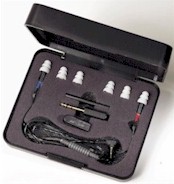| Columns Retired Columns & Blogs |
Etymotic Research ER-4S Canal Phone earspeakers
The cab's outside, the plane leaves in 50 minutes. Let's see...HeadRoom Supreme, HeadRoom Bag, portable CD player, CDs, Etymotic ER-4S Canal Phones....Oh, yeah—mustn't forget luggage or plane tickets. Guess I'm set to go.
Footnote 1: Vol.17 No.12, p.128.
Laugh if you will at my priorities, but I'm much likelier to leave on a trip without my suitcase or my tickets than without a pair of Etymotic's unique "headphones." After all, what's more important: clean underwear or good music? Okay, okay—I'd rather have both, but what's personal hygiene compared to musical ecstasy?
 The Etymotic Research ER-4S Canal Phone earphones are unlike any other "headphone" you're likely to have experienced. First, note their designation as "canal phones." It's accurate—these babies fit tightly inside your ear canals, aiming directly at your eardrums from millimeters away. The result—if the ear-tips are properly seated in the canal, creating a tight seal—is profound bass, direct and distortionless response, and phenomenal isolation from environmental noise. Etymotics are essential tools for travel, although I don't tend to use them at home, since I find the Sennheiser HD-580s (reviewed in December '94, footnote 1) far more comfortable. Also, I generally want to hear environmental sounds such as ringing telephones or doorbells at those times.
The Etymotic Research ER-4S Canal Phone earphones are unlike any other "headphone" you're likely to have experienced. First, note their designation as "canal phones." It's accurate—these babies fit tightly inside your ear canals, aiming directly at your eardrums from millimeters away. The result—if the ear-tips are properly seated in the canal, creating a tight seal—is profound bass, direct and distortionless response, and phenomenal isolation from environmental noise. Etymotics are essential tools for travel, although I don't tend to use them at home, since I find the Sennheiser HD-580s (reviewed in December '94, footnote 1) far more comfortable. Also, I generally want to hear environmental sounds such as ringing telephones or doorbells at those times.
However, whenever I take a trip, the ER-4Ses, my HeadRoom Supreme, and a portable CD player are the first things I pack. The noise-canceling feature of the Etymotics helps combat the fatigue of high-ambient-noise environments—such as airplane or train compartments—and I can get a lot of very-high-quality listening done during transit. Not that I like them because they make me "efficient"—I'm a great believer in creatively wasting time—I just want to waste time doing what I like, not what I'm forced to.
And that's the real reason I love the ER-4Ses: they allow me to control when and where I listen to music. Besides, as much as I love my Sennheisers, their open-back design makes them impractical out in the world: my seat companion would receive far too much of my music—not to mention my receiving far too much background noise—and I'd feel like a dork walking around with a big ol' pair of cans on my head.
Ear! ear!
The Etymotic ER-4Ses are as compact as headphones can get—at least until we have direct neural stimulation. In fact, it almost looks like the wiring harness for a headset, lacking the earpads themselves. Sony's Fontopid ear-buds are the closest analog, but do not be misled (mizzled, captain?)—rather than resting in the outer ear like the Sonys, these babies get shoved into the canal itself and end up with the transducer fractions of an inch away from the eardrum.
The capsules containing the transducer are inserted into small soft plastic "earmolds"—flanged, conical tips that resemble nothing so much as the Civil War "minnie balls" that my friends and I used to scavenge from old battlefields. The acoustic seal created by these flexible tips simultaneously isolates the listener from the environment and couples the transducer to the eardrum, effectively reinforcing low-frequency response. Important end-user tip: Failure to properly seat the earmold results in shrill sound that's totally lacking in body.
The Etymotic has a stiff 4' cable terminating in a 1/8" stereo miniplug, and it comes with a 1/8"-¼" adaptor. Included with the 'phones are three pairs of the plastic ear-molds, as well as five pairs of open-cell foam cylinder molds—designed to sit in the outermost portion of your ear canal—for those with an aversion to placing foreign objects in their ear canals.
You also get a filter-replacing tool. Wha zat? Well, in the tips of the Etymotic's ear pieces—housed under the ear molds—are itty-bitty replaceable filters. Keep in mind that once you've sealed your ear with the flanged ear-molds, you've got a passage with an ambient temperature of about 100 degrees, and even in meticulously maintained ears like yours—and mine, too, of course—there's a certain amount of, uh, wax. This will liquefy and migrate, so Etymotic provides a replaceable trap—the filters—to capture the wax and prevent it from fouling the transducer itself.
But that's not all it does. It also serves as part of the equalization curve that matches the acoustic impedance inside your ear to that of freefield response, where dispersion "softens" HF response. Take out the filter and listen—as Tyll Hertsens of HeadRoom suggested I do—and man! the shrillness will take the top of your head off. The filter-replacing tool has a hollow compartment that holds additional filters—just be careful when you open it or you'll be down on your hands and knees, shining a flashlight along your floorboards, trying to find the strays. Like I was.
Footnote 1: Vol.17 No.12, p.128.
- Log in or register to post comments




































